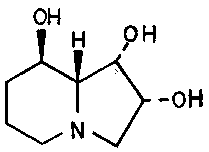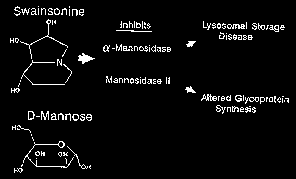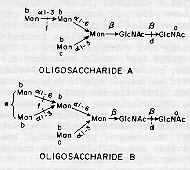Swainsonine

illustration from Keeler, 1988
This indolizidine alkaloid acts as a reversible inhibitor of lysosomal alpha-mannosidase and of the Golgi complex alpha-mannosidase II. The structure of swainsonine mimics the shape of a cation intermediate involved in mannose hydrolysis, making a potent enzyme inhibitor. Due to the low pH of the compartments in which the targeted mannosidases work (~pH 4.5), and the weakly basic nature of swainsonine, it will tend to concentrate in them in amounts necessary for near complete inhibition Dorling, Huxtable, Colegate, Winchester 1984).

illustration from Stegelmeier et al. 1995
The result of lysosomal alpha-mannosidase inhibition is accumulation of partially processed oligosaccharides and glycoproteins in the lysosomes or lysosomal storage disease. Swainsonine causes further disruption of glycoprotein processing through golgi complex alpha mannosidase II inhibition.
 GaM II is an important enzyme for the glycosylation of asparagine residues in many different proteins. (Stegelmeier et al 1995 )
Some possible structures for the resultant oligosaccharides in storage are shown here (from Tulsiani et al. 1984).
Lysosomal storage disease due to swainsonine toxicity results in a condition known as locoism. Swainsonine toxicity also has a number of other effects.
GaM II is an important enzyme for the glycosylation of asparagine residues in many different proteins. (Stegelmeier et al 1995 )
Some possible structures for the resultant oligosaccharides in storage are shown here (from Tulsiani et al. 1984).
Lysosomal storage disease due to swainsonine toxicity results in a condition known as locoism. Swainsonine toxicity also has a number of other effects.
Swainsonine Poisoning
Return to the Astragalus toxicology main page